Industrial Metal Detector
| Materials: | Sand, gravel, crushed stone, coal, limestone, gypsum, and bulk raw materials |
| Detects: | Ferrous tramp |
| Applications |
Quarrying, mining, recycling, aggregate, mineral processing & bulk material handling |






TN77 Industrial Metal Detector
The Bunting TN77 Conveyor Metal Detector is a rugged, tunnel‑type system designed for continuous detection of ferrous tramp and manganese steel contamination in conveyed materials. It excels in mining, quarrying, recycling, aggregate, and bulk material handling applications; protecting downstream equipment, ensuring product purity, and reducing downtime.
- About
- Benefits
- Applications
- How It Works
The TN77 Industrial Metal Detector is built to safeguard processing equipment by detecting tramp iron and manganese steel hidden in conveyed materials. Typical contaminants include digger teeth, drill rods, and crusher liners that, if not removed, can cause severe damage to crushers, screens, and conveyors. By identifying these hazards early, the TN77 helps prevent equipment breakdowns, unplanned downtime, and costly repairs.
Designed as a tunnel-type unit, the TN77 is easy to install on both new and existing conveyor systems. The split-frame coil makes it possible to fit the detector without cutting the belt, reducing installation time and disruption. Once in place, the TN77 provides continuous inspection of bulk materials such as sand, gravel, coal, limestone, and ores, ensuring reliable protection in high-throughput operations.
Operators value the TN77 for its straightforward controls, low maintenance requirements, and consistent performance in tough environments. Its rugged construction makes it suitable for dusty processing plants as well as outdoor installations in quarries and mines. With adjustable sensitivity settings, the TN77 delivers dependable performance across a wide range of applications.
Reliable Tramp Metal Protection
Identifies damaging contaminants like digger teeth, drill rods, crusher plates, bars, chains, nuts, and bolts to avoid costly equipment failures.
Handles Manganese Steel & Ferrous Metals
Detects both typical ferrous tramp and contaminants like manganese steel pieces.
Adjustable Detection Sensitivity
Fully adjustable detection level
Ignores Non‑Magnetic Belt Components
For example, copper‑alloy belt fasteners are overlooked, reducing false alarms.
Customizable Coil/Aperture Sizing
Standard search coil sizes are available; custom apertures supplied to suit different belt widths and material profiles.
Tunnel Design & Retrofit‑Friendly
Can be fitted onto existing conveyors without needing to remove or cut the belt; coil can be dismantled for easier installation.
Control Options & Alarms
Features an IP rated control cabinet (often wall‑fixed, local or remote), with visual or audible alarms; supports interlocking belt stop or reject mechanisms.
Prevents Equipment Damage and Downtime
Stops tramp metal from entering crushers, screens, and conveyors, reducing wear, maintenance costs, and unexpected shutdowns.
Built for Demanding Environments
Engineered with an open-drainage design, the TN77 allows water to flow freely through vented channels in the top bar; supporting reliable operation in demanding processing environments.
Low-Maintenance Operation
With no moving parts and rugged components, the TN77 delivers long-term protection with minimal service needs.
- Aggregate, mining, and quarry operations (rock, stone, sand, gravel) where tramp metal causes crusher, screen, or conveyor damage.
- Recycling facilities where contaminated materials can damage processing or reduce product purity.
- Bulk material handling operations involving coal, minerals, chemicals or wood chips, where metal contaminants reduce throughput or product quality.
- Lead-acid battery recycling plants, where units are fiberglass-wrapped for acid protection, ensuring long-lasting performance in highly corrosive environments.
- The TN77 consists of a search coil (tunnel‑type) that material passes through, and a control unit housed in an enclosure (commonly wall‑mounted, local or remotely located).
- On detecting tramp metal, the coil sends a signal to the control unit, which processes it and triggers one or more control actions (stop belt, alarm, reject mechanism, or marking device).
- Designed for continuous inspection of non‑metallic or non‑conductive load materials such as limestone, granite, sand & gravel, clay, coal, chemicals, wood chips, mineral ores etc.
Application Photos
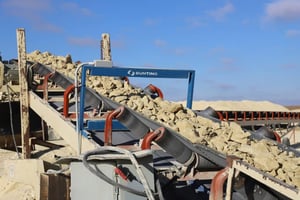

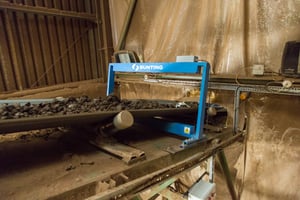
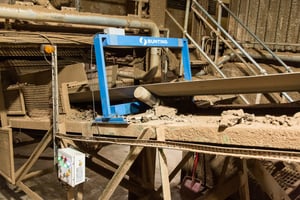
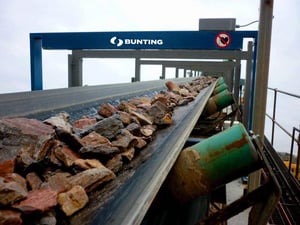
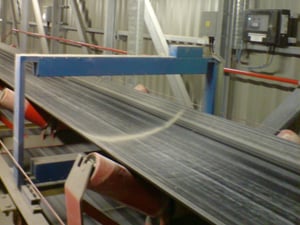
FAQ's
The TN77 is designed to detect ferrous metals and manganese steel that are considered foreign or tramp to the conveyed product. It detects these materials through magnetic field distortion as they pass through the coil.
Yes. The TN77 is capable of ignoring non-ferrous belt fasteners such as copper alloy clips, preventing false detections while maintaining high sensitivity for actual tramp metals. A belt clip detector can be supplied as an optional extra.
The TN77’s control cabinet can be installed up to 100 meters from the search coil, provided proper shielding and separation from power cables is maintained.
When metal is detected:
-
A red indicator light (Metal 1) is illuminated.
-
The control relay is activated, which can stop the belt, trigger alarms, or activate a reject system.
-
If a second metal piece is detected before the first is cleared, a second red light (Metal 2) is triggered, alerting the operator to search for multiple items.
Yes. The TN77 includes shock absorbers to mitigate vibration and includes installation best practices such as:
-
Keeping large moving metal objects 500mm or more away
-
Avoiding power line interference
-
Isolating the coil from vibrating structures.
Routine checks are recommended:
-
Inspect the coaxial cable for damage or movement
-
Ensure search coil components are tightly secured
-
Confirm the shockmounts are clear of dust and debris
-
Test system sensitivity with sample metal pieces regularly.
The TN77 is installed by fitting the search coil around the conveyor belt, locating the control unit nearby, and connecting them with a screened cable. It is mounted vibration-free, between idlers, and integrated with the conveyor’s control systems to stop the belt or trigger alarms when tramp metal is detected.
Application Photos
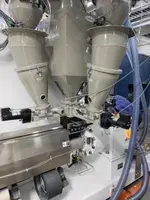







Talk to an Application Engineer
Not sure what you need? Let’s talk through your application and identify the right solution.

